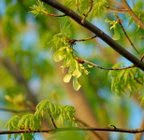An inspirational paragarph from "Making a Landscape of Continuity The Practice of Innocenti and Webel" edited by Gary R. Hilderbrand.
There is one abiding, resounding physical characteristic that is evident in the entire body of work of Innocenti & Webel, a characteristic that is classical and also not classical; it is both modern and timeless. It is the structuring of physical space with trees—trees in rows, closely spaced, often repeating as far into the distance as we can see. For landscape architecture, an activity that always deals with our constructed relation to the natural world, the simple ordering of trees is an extraordinary act, one not to be underestimated. Trees in measured arrangements give expression to a thought about the world, about the human need for measure, for articulation, for clarification. With trees in space, we can sense the horizon, we can understand distance, we can measure the scale and size of objects in our sight. With a canopy overhead, we may sense the ground not as a surface but as a space, a site of inhabitation, a place to move or to rest. With trees in parallel lines, we may perceive a space for movement, a pointing, a suggestion of speed, a path toward a destination. And when we are close to trees, we find a new measure for ourselves, smaller, or larger, but real and physical. With trees we know space.
Reading of Innocenti & Webel I get a sense that they were masters of articulating the tree. Trees are not man-made. But we corral them and turn them into soldiers of the landscape. The spacing and the rhythm contrasts with their organic shape and our inability to control the shape of every last branch. They stand as sentinels to our longing of order.
Trees offer much more than their fundamental characteristic of shape. Trees can speak to region. They can talk of water or the lack there of. They can touch our emotion through scent and texture.
Walking through a grove of cottonwood and willow can transport you to a mountain stream. The chattering water is heard in the cottonwood and the low whisper of the willow masks the sounds of the present.
It only takes a view of a copse of cypress and black marshy water framed with the knees of the oxygen deprived tree comes to mind. If you have experienced the cypress up close and personal, then its fragrant needles, unique pitchy cones and auburn fall color creep into your senses.
It is the pine that touches me with a longing for home. I am immediately taken to a high mountain lake that I use to swim in as a boy. The rushing of wind thru the canopy of needles speaks only of a mountain breeze. But it is the fragrance. The intense fresh smell that only the pine can express. It is the scent of rusty, dry needles under my feet. It is the scent of rough and furrowed bark. It is the scent of cool deep water waiting to be dove into. It is the scent of laying on my back and gazing up through the wispy needles.
Combining the use of form and rhythm with the memory that the tree evokes in each of us is a powerful tool to put in my toolbox (as my friend Brent would say.)
It seems that there is so much that goes into design. I see my designs getting cluttered and incoherent. The designs of Innocenti and Webel seem clear and pure. They are soft and calm. They are delightful and yet restful to the eye.


